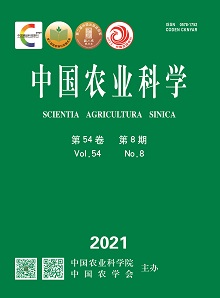【Objective】Cultivated peanut (Arachis hypogaea L.) is an important oil and economic crop in worldwide. Plant type is a typical quantitative trait and an important agronomic trait, which is closely related to yield and mechanized harvesting in peanut. Genetic analysis, QTL mapping and identifying tightly linked molecular markers of plant type, will be conducive to the germplasm protection and cultivar identification, and provide an important theoretical basis for the molecular breeding of plant type in cultivated peanut. 【Method】In the present study, a RIL population as research material was established, which consisted of 321 families and derived from Jihua 5 with erect plant type and M130 with prostrate type. Two parents and RIL population were planted at Hainan city, Handan city, Baoding city and Tangshan city during the growing season (May to September) from 2016 to 2018. The phenotypic data of plant type related traits, such as lateral branch angle, main stem height, lateral branch length, index of plant type and extension radius, were investigated at harvesting season under seven environments. Meanwhile, SSR, AhTE, SRAP and TRAP were used to identify genotypic data of parents and RIL that was applied to construct the molecular genetic linkage map. Later, we combined phenotypic data of seven environments, and identified QTLs for plant type related traits using ICIM of QTL Icimapping V4.2. 【Result】A molecular genetic linkage map containing 363 polymorphism sites was constructed, and all markers were assigned to 20 chromosomes and an unknown linkage group. The total length of the map covered 1 360.38 cM of the whole genome, and the average distance between the markers was 3.75 cM. The length of a single linkage group was 39.599-101.056 cM, including 4-50 molecular markers. Subsequently, 30 additive QTLs for plant type related traits were detected by ICIM-ADD method, which were distributed on A04, A05, A06, A08, A09, B02 and B09 chromosomes. Among these QTLs, 5 QTLs for LBA with PVE was 3.48%-11.22%, 15 QTLs for MSH with PVE was 3.58%-10.05%, 2 QTLs for LBL with PVE was 6.03%-8.56%, 4 QTLs for IOPT with PVE was 4.68%-15.08%, 4 QTLs for ER with PVE was 3.30%-9.33%. Of these, qLBAA05.1, qLBAA05.2, qMSHA04.2, and qIOPTA05.1 were main-effect QTLs, explaining 11.22%, 10.59%, 10.23%, 10.05% and 15.08% of the phenotypic variance, respectively. In addition, 59 pairs epistatic QTLs were detected by ICIM-EPI method. Among them, 6 pairs of epistatic QTLs for LBL with PVE were 2.23% to 2.78%, 50 pairs of epistatic QTLs for IOPT with PVE were 0.25% to 1.44%, and 3 pairs of epistatic QTLs for ER with PVE were 7.28% to 12.25%. Finally, we also found 3 QTL clusters for LBA, MSH, IOPT and ER on GM1867-AHGS1967 interval of A04, me14em5-116-PM418 interval of A05 and HBAUAh177-AhTE0658 interval of A08, respectively. 【Conclusion】In brief, we constructed a molecular genetic linkage map containing 363 loci, and identified 30 additive QTLs and 59 pairs of epistatic QTLs for plant type related traits, and found 3 QTL clusters.









